I wanted to start this article with something bizarre or shocking about papayas — a factoid or legend that would immediately grab your attention and draw you in. A story about the dangerous Running with the Papayas festival in Pamplona, Spain, or the famous Psychic Papaya of Enfield, Connecticut, or even the quirky “Take Your Papaya to Work Day” tradition inspired by a popular Mexican sitcom.
But alas, none of these is remotely real. As far as I can tell, papayas have been flying under the radar of popular culture for hundreds of years. The best I could come up with is the Nahuatl name for the fruit, chichihualtzapotl, which translates to “sweet fruit of the wet nurse.”
So in order to get you excited about papaya, I’m going to have to rely on its intrinsic value: its fabulous sweet taste, culinary versatility, and considerable nutritional benefits.
While less common in the US than its tropical cousins, mangoes, bananas, and pineapples, the papaya is nonetheless a global superstar. In fact, it’s the fourth most traded tropical fruit, after the three I just named.
The majority of the world’s papayas come from only ten countries, with India, Brazil, Indonesia, Nigeria, and Mexico leading the pack. The US produces only a tiny fraction of the world’s supply but is the largest papaya importer, getting most of them from Mexico.
In the places where they grow, papayas are both an important source of nutrition as well as a common ingredient in traditional medicine. So what are the health benefits of papayas? And are there any downsides to their consumption?
What Is Papaya?
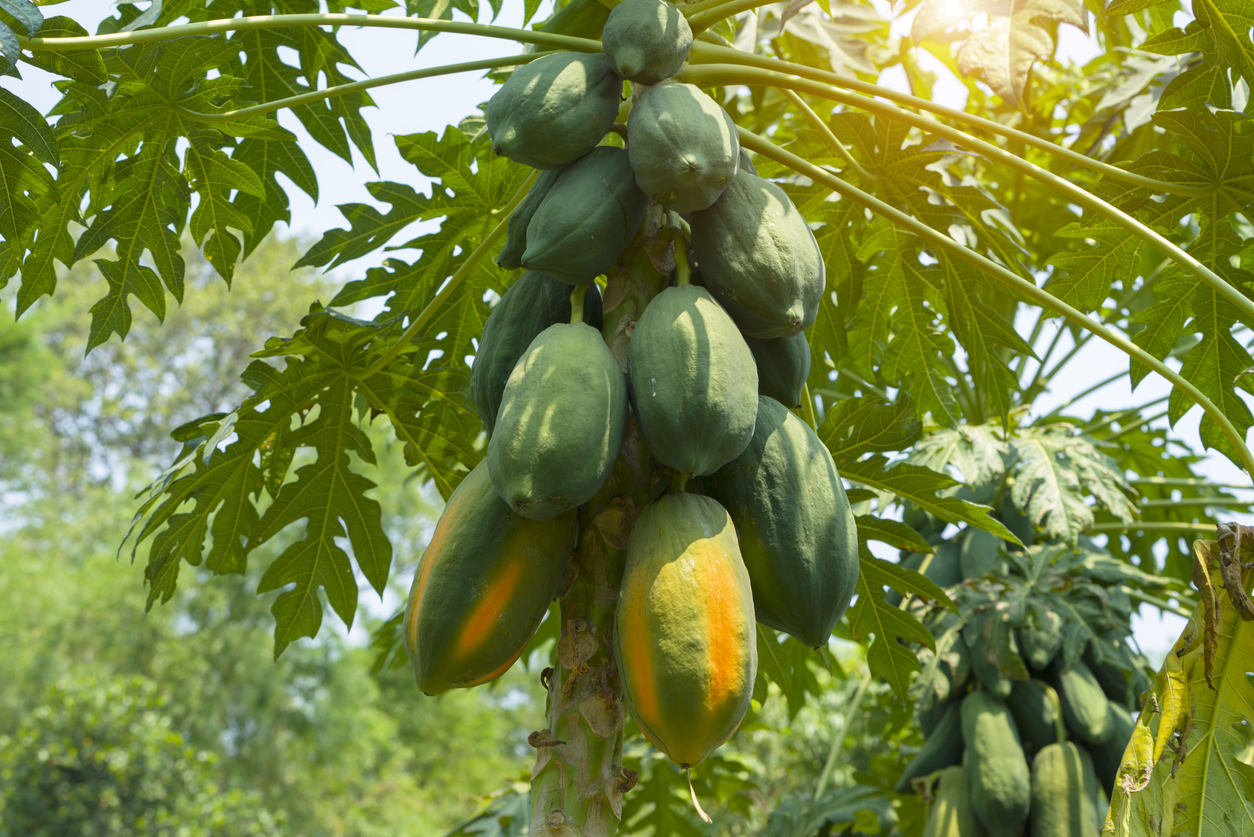
The papaya is known botanically as Carica papaya, which is actually a mistake. It’s named after the fig tree, Ficus carica because early botanists saw enough resemblances between papaya and fig leaves to think they were closely related. You’ll have to excuse them. The papaya is a tricky plant in many ways. While it looks like a tree, it’s actually an herb. And its fruit, thought by many to be a melon, is botanically a berry.
Speaking of confusing names, papaya is called “pawpaw” in Australia but is different from the North American pawpaw (Asima triloba), which belongs to a completely different family.
The papaya is a tropical fruit whose skin ranges in color from pale green to safety yellow to sunset orange. And its flesh can be anywhere from red to orange to yellow to pink (and possibly some of the more obscure Crayola colors, including Mango Tango, Atomic Tangerine, and the decidedly un-vegan Macaroni and Cheese).
Most scholars of papayology (yes, I made that up; and no, I’m not thinking of copyrighting it) believe the plant to have originated somewhere around southern Mexico or eastern Central America. By the time Spanish conquistadors arrived, the fruit had spread throughout Central and South America. The Spanish took papaya seeds with them to other tropical regions, including the Caribbean (remember that swashbuckling blockbuster, “Papayas of the Caribbean”?) and southeast Asia, where the plants flourished and soon found their way into local cuisines.
Types of Papaya
There are two main types of papaya fruit: Mexican and Hawaiian. Mexican papaya is by far the more common one, shaped like a semi-deflated American football and reaching up to 15 inches in length. Most papayas imported into the US are this kind. And with the exception of the Big Island of Hawaii, it’s the variety grown in most US states with tropical or semitropical climates. The most common Mexican papaya cultivar is called Maradol, which originally comes from Cuba.
Hawaiian papayas are smaller and often sweeter than Mexican varieties, with thicker skin. The best-known cultivar is Solo, which actually originated in Barbados and made its way to Hawaii. One concern with Hawaiian papayas is that the majority of them — roughly 82% — are now bioengineered (aka GMO). We’ll talk more about this in a bit.
A third variety of papaya is Thai Green, which is meant to be eaten before ripening and turning yellow. While you can technically eat any unripe papaya at its green stage, this particular variety, used both raw and cooked in Thai recipes, is elongated (kind of like a hefty burpless cucumber) with a thin, smooth, firm, and slightly waxy skin.
Papaya Nutrition
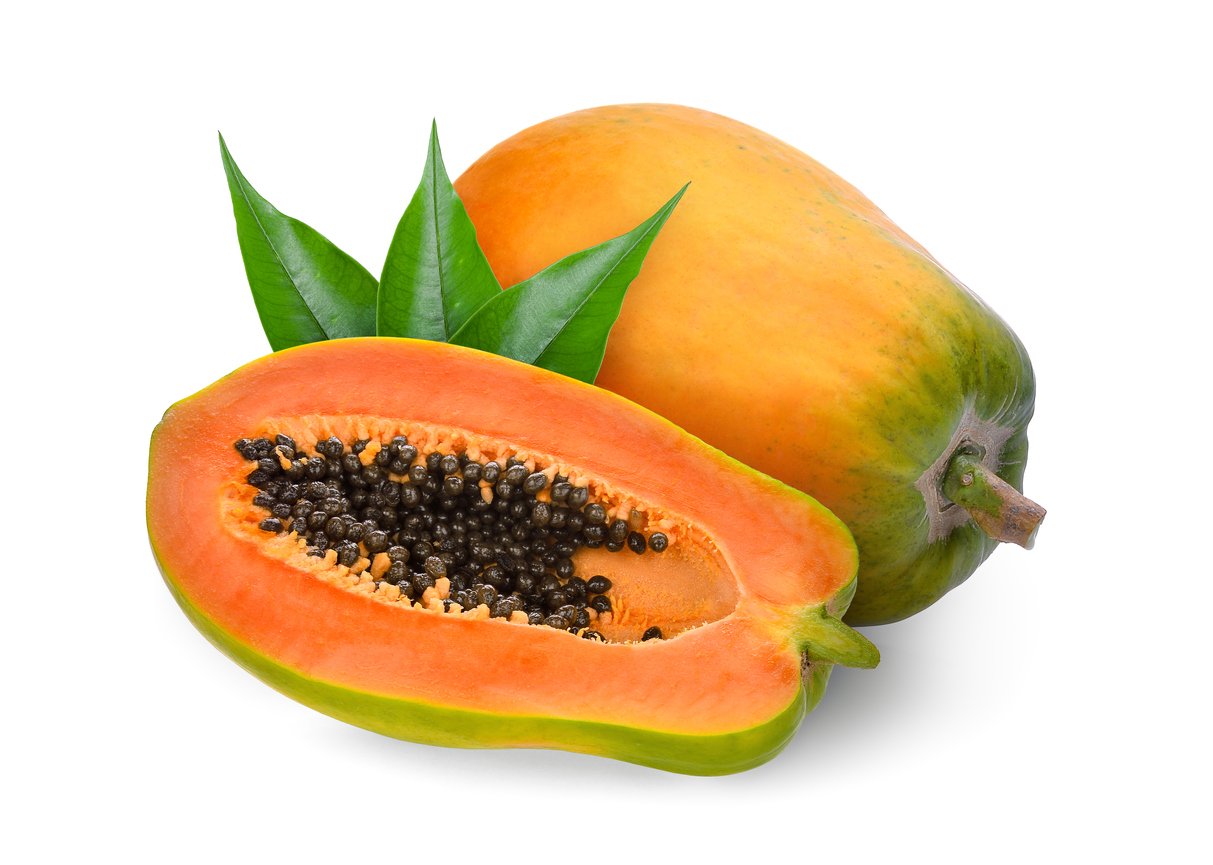
The first thing you’ll notice when you pick up a papaya at the grocery store is it’s pretty heavy for its size. That’s because, by weight, the papaya is 88% water. It’s a very hydrating food — almost up there with the watermelon’s 92% (and papaya doesn’t even advertise “water” in its name).
Papaya is also a good source of minerals like potassium and magnesium, and vitamins such as A, C, and folate (B9).
Papaya is high in antioxidants like lycopene and carotenoids. And these phytonutrients appear to be more bioavailable in papaya than in many other sources, including tomatoes and carrots.
Additionally, papaya is low in fat and protein, but it does provide a modest amount of fiber — roughly 2.5 grams per cup of fruit.
What Is Papaya Good For?
A 2022 review of papaya by an international team of scientists called the plant a “quasi-drug,” thanks to its broad range of pharmaceutical properties. The authors note that the plant’s fruit, seeds, and leaves have been used in traditional medicine for centuries. Let’s survey some of papaya’s most examined and important health benefits.
Papaya and Digestion
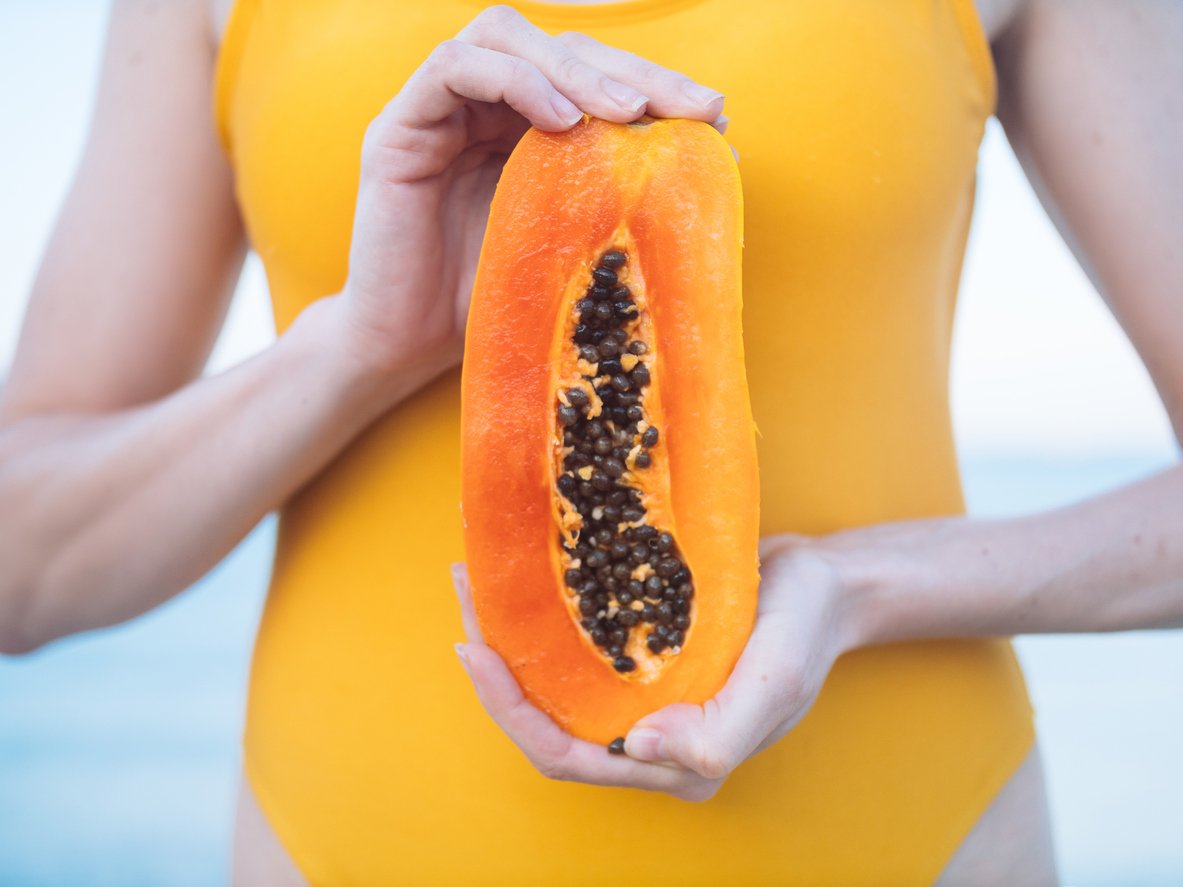
Papaya contains a substance called papain, a protease enzyme (which doesn’t mean it’s an expert at making fun of people, but rather that it breaks down proteins).
A 2022 study explored the effect of papain on the health of intestinal tissue taken from humans and mice. (Our view on the use of animals in medical research is here.) And the researchers found that papain changed the composition of gut bacteria for the better, growing the populations of beneficial strains and reducing the concentrations of harmful ones. It also increased the activity of a digestive enzyme produced by the pancreas and thickened the linings of intestinal walls.
A 2021 study also looked at how the fiber from unripe and ripe papayas affects the bacteria in the human gut that produce short-chain fatty acids (SCFAs), which are beneficial for both gut and overall health. Both types of fiber increased the growth of beneficial Clostridium and Bacteroides bacteria species and increased SCFA production.
Papaya Cancer Benefits
The chemical makeup of papaya suggests that the fruit may possess anticancer properties. A 2014 study tested this hypothesis by examining what ripe papaya extract did to two strains of human breast cancer — one hormone-dependent, and one non-hormone-dependent. Researchers found that the papaya extract was both antioxidant and antiproliferative (meaning it inhibited the growth of the cancers in vitro), and was able to induce cell death in both cancer lines.
The 2021 review article mentioned in the previous section also notes that the antioxidant activity of papaya could help fight skin cancer and other types of cancer by preventing damage to cells that might otherwise become cancerous.
Papayas and Metabolic Syndrome
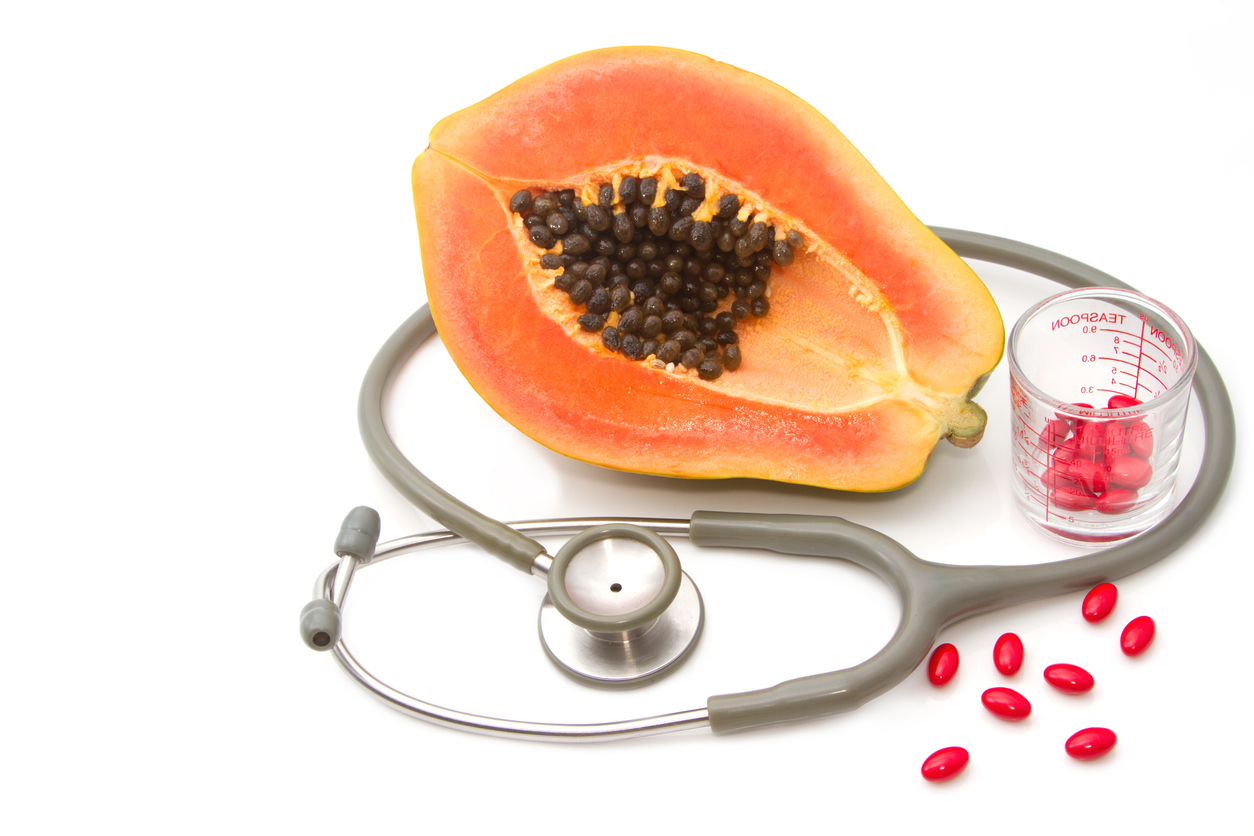
A 2019 review article out of Brazil reported that the nutrients in papaya have positive effects on the cardiovascular system, protecting it from disease and damage caused by free radicals. The fruit has also shown potential for the treatment of diabetes and the reduction of cholesterol levels, which may improve metabolic syndrome.
Papaya pulp, seeds, and leaves have antioxidant, antihypertensive (blood pressure lowering), hypoglycemic (blood sugar lowering), and hypolipidemic (cholesterol-lowering) properties — all useful in preventing and treating obesity and related metabolic disorders.
A 2023 study examined the effects on human cells of beneficial polyphenols in both ripe and unripe papaya pulp and seeds. Whether ripe or unripe, the researchers found that papaya helped cells to take in glucose, and reduced triglyceride levels.
Papaya Eye Benefits
Some studies have shown that the carotenoid lycopene can protect retinal cells of the eye from oxidative stress and inflammation, reducing cataract formation and slowing the development of diabetes-induced retinopathy. And papaya turns out to be one of the top sources of lycopene.
Papaya also contains a modest amount of the phytonutrients lutein and zeaxanthin, which can protect eyes from age-related macular degeneration and cataracts.
[Find out more on how to eat for healthy eyes.]
Papaya and Inflammation

Chronic inflammation is at the root of just about every disease, so eating anti-inflammatory foods is one of the keystones of a healthy lifestyle. Papayas also fit the bill here, thanks to their high levels of antioxidants and phytonutrients.
There are many antioxidants in papaya, including caffeic acid, myricetin, rutin, quercetin, alpha-tocopherol, papain, benzyl isothiocyanate (BiTC), and kaempferol. They help protect your body from the damage caused by oxidative stress.
Studies have shown that papaya extract can decrease free radicals in the body, inhibit the release of certain enzymes that accelerate inflammation, and mitigate some of the harmful effects of a high-fat diet.
A 2021 review article also suggests that extracts from papaya could be incorporated into drugs or supplements to help treat various diseases by countering the effects of harmful chemicals called reactive oxygen species (ROS). As a fan of whole food, I’m more partial to just eating papaya, so we don’t have to wait for the pharmaceutical and supplement industries to create expensive papaya pills in order to bring down oxidative stress and inflammation.
Papaya Downsides and Risks
Even with all that good news about papaya, life is not all unicorns and rainbows in papaya land. There are at least three issues to contend with when considering whether to incorporate papayas into your diet: bioengineering, allergic reactions, and food waste.
GMO Papayas
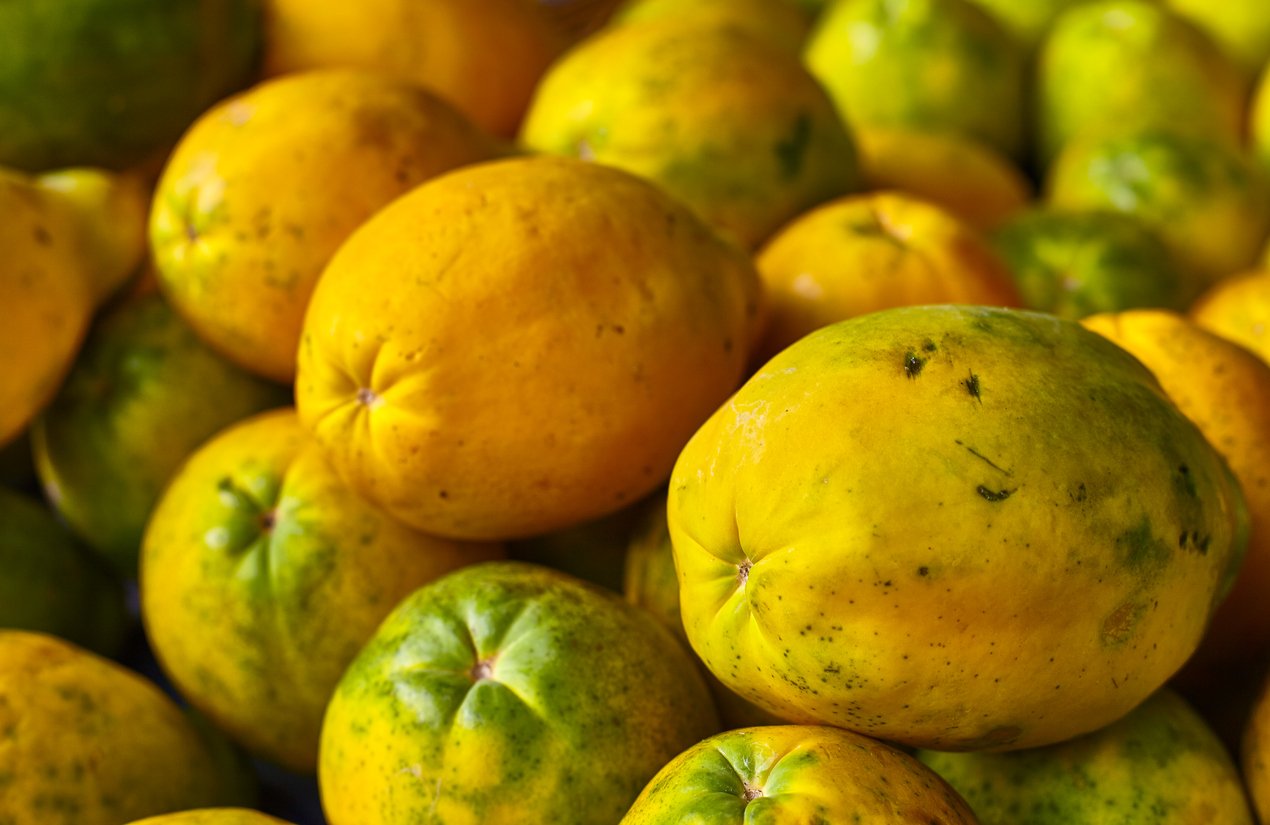
As mentioned earlier, most of the Hawaiian papayas you’ll find are genetically modified (or, put another way, bioengineered).
Hawaii produces mainly small-sized Solo-type papayas, which include Kapoho, Sunrise, SunUp, and Rainbow varieties. Kapoho and Sunrise are not bioengineered cultivars, while Rainbow and SunUp are. And unfortunately for fans of Mother Nature, more than three-quarters of all Hawaiian papayas are the bioengineered Rainbow type.
Bioengineered papayas came about because the Hawaiian papaya industry was threatened with collapse in the 1970s when the papaya ringspot virus began decimating crops. This disease nearly wiped out entire papaya farms, so growers turned, understandably, to bioengineering to create papayas resistant to the virus.
China also produces a type of GMO papaya called Huanong No. 1, which came about in 2006. But its resistance started breaking down about six years later, as researchers discovered transgenic varieties infected with the virus despite their genetic modifications.
Although there’s currently no evidence to suggest these papayas are unsafe for consumption, or that they contribute to food allergies, some people still worry that there’s just not enough research to feel confident eating them. If you want to avoid GMO papayas, go for the Kapoho or Sunrise Hawaiian papayas, or try one of the far more prevalent Mexican or Thai varieties.
Papayas grown organically are always non-GMO, with the added advantage of reducing exposure to pesticides, which is good for consumers, farmworkers, and the environment. If you can’t access organic papayas, you can still reduce your pesticide exposure by choosing Mexican varieties, which are not only non-GMO but are also on the Environmental Working Group’s Clean Fifteen list.
Papaya Allergy
Papayas are among the fruits most likely to trigger allergy symptoms in susceptible people. They may cause oral allergy syndrome due to polygalacturonase, a protein enzyme that is also a pollen allergen found in cedar and cypress trees. These proteins can confuse the immune system in people with food or outdoor allergies, the most frequent reaction involving itching or swelling of the mouth, face, lips, tongue, and throat.
Because papaya pulp and peel contain latex, they can also trigger cross-reactions in people with latex allergies, leading to a condition called latex-fruit syndrome. People with this condition must avoid contact with both rubber latex and latex-containing foods of fruit or vegetable origin, or they may suffer hives, gastrointestinal symptoms, and in severe cases, anaphylaxis.
While these problems are rare, they are serious. So if you’re allergic to papaya, then, of course, you should probably stay away from them.
Papaya Food Waste Issues
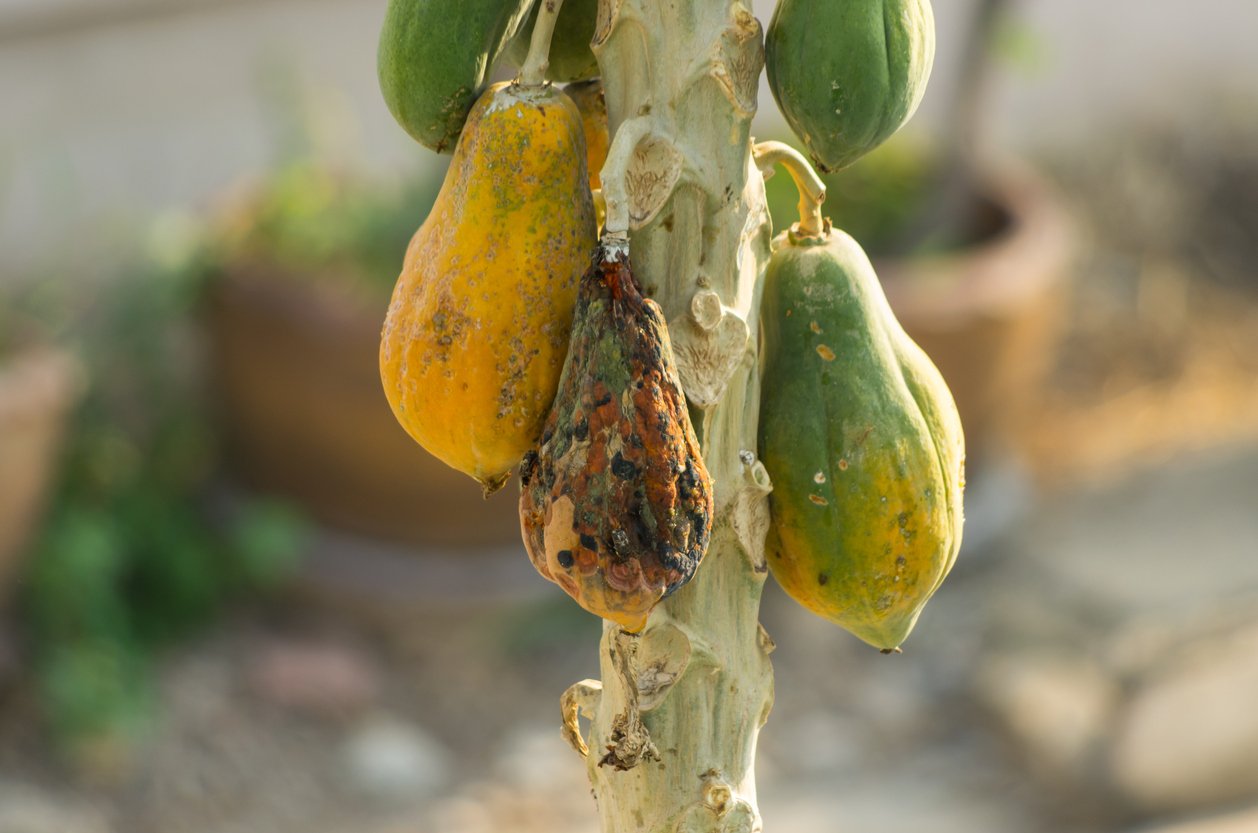
Food waste is a big issue, especially in a world that overuses natural resources like clean water and has a global hunger problem. While a lot of the food waste occurs in our grocery stores, restaurants, and home kitchens, some crops are particularly susceptible in the fields. Hawaiian papayas, in particular, are a wasteful crop; fully one-third of Hawaiian papaya crop is discarded because it’s bruised or misshapen.
But there’s some good news on the horizon: Researchers are working to turn discarded papayas into biofuel by feeding them to a type of green algae to create energy. The hope is, this fuel may help make Hawaii energy independent eventually.
[Find out more about food waste and how to prevent it.]
Papaya in Perspective
Papaya is a delicious and nutritious tropical fruit that offers a range of health benefits — from aiding digestion and improving metabolic syndrome to promoting eye health and helping to prevent cancer.
With its high levels of fiber, vitamins, and antioxidant phytonutrients, papaya is an excellent addition to a healthy and balanced diet. As with any food, however, it’s important to be aware of the potential risks, especially to those with a known latex or pollen allergy.
For most people, though, adding papaya to meals and snacks can be a tasty way to boost health and wellness. And if you want to avoid GMO papaya varieties, stick to Mexican, Thai, or the Hawaiian Kapoho and Sunrise types.
Tell us in the comments:
-
Have you eaten Mexican or Hawaiian papaya? If you’ve tried both, what’s your preference?
-
Do you have any fruit, pollen, or latex allergies? What do you do to avoid triggering them?
-
Do you try to avoid bioengineered crops?
Featured Image: iStock.com/Nungning20



